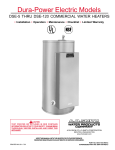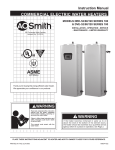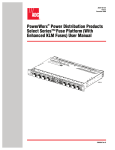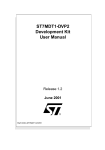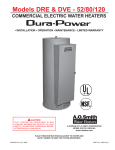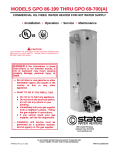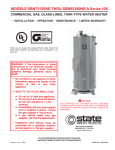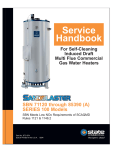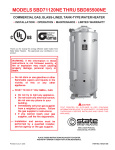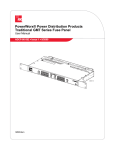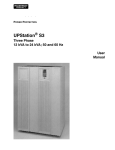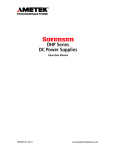Download State Industries ASME SSE-120 User's Manual
Transcript
STATESMAN Electric Models TM SSE-5 THRU SSE-120 COMMERCIAL WATER HEATERS • Installation • Operation • Maintenance • Checklist • Limited Warranty CAUTION TEXT PRINTED OR OUTLINED IN RED CONTAINS INFORMATION RELATIVE TO YOUR SAFETY. PLEASE READ THOROUGHLY BEFORE INSTALLING AND USING THIS APPLIANCE. 500 Lindahl Parkway Ashland City, TN 37015 KEEP THIS MANUAL WITH THE HEATER FOR FUTURE REFERENCE. WHENEVER MAINTENANCE ADJUSTMENTS OR SERVICE IS REQUIRED. PRINTED IN U.S.A. 0203 PART NO. 09063322 1 DIMENSIONS Tank Capacity in Gals.(Ltrs) 5 19 10 38 20 76 30 114 40 151 50 189 65 246 80 303 100 379 119 450 Maximum KW Input 3 6 18 24 36 90 90 90 90 90 A 20 26 27 35 45 54 50 49 58 63 1/2 1/4 1/4 3/4 3/4 3/4 1/2 1/4 1/4 1/4 521mm 667 mm 692 mm 908 mm 1,162 mm 1,391 mm 1,283 mm 1,251 mm 1,480 mm 1,607 mm All Dimensions B 16 1/4 413 mm 18 3/4 476 mm 20 1/2 521 mm 20 1/2 521 mm 20 1/2 521 mm 20 1/2 521 mm 24 1/2 622 mm 26 1/2 673 mm 26 1/2 673 mm 28 711 mm in Inches (mm) C 21 1/2 546 mm 24 610 mm 27 686 mm 27 686 mm 27 686 mm 27 686 mm 30 1/4 768 mm 32 1/4 819 mm 32 1/4 819 mm 33 3/4 845 mm D 5 1/4 5 1/4 5 3/4 5 3/4 5 3/4 5 3/4 7 7 7 7 1/2 133 mm 133 mm 146 mm 146 mm 146 mm 146 mm 178 mm 178 mm 178 mm 191 mm Approx. Ship Wt.Lbs.(Kgs) 82 37.2 106 48.1 130 59 150 68 190 86.2 221 100.2 267 121.1 285 129.3 354 160.6 420 190.5 RECOVERY CAPACITY RECOVERY RATE IN GALLONS PER HOUR * Temperature Rise F° (C°) STANDARD KW INPUT INPUT BTUH 3 10,239 6 20,478 9 30,717 12 40,956 15 51,195 18 61,434 24 81,912 30 102,390 36 122,868 45 153,585 54 184,302 60** 204,780 75** 255,975 90** 307,170 F° C° GPH LPH GPH LPH GPH LPH GPH LPH GPH LPH GPH LPH GPH LPH GPH LPH GPH LPH GPH LPH GPH LPH GPH LPH GPH LPH GPH LPH 40F° 22C° 31 116 61 232 92 349 123 465 153 581 184 697 246 929 307 1162 368 1394 460 1743 552 2091 614 2324 767 2905 921 3485 50F° 28C° 25 93 49 186 74 279 98 372 123 465 147 558 196 744 246 929 295 1115 368 1394 442 1673 491 1859 614 2324 737 2788 60F° 33C° 20 77 41 155 61 232 82 310 102 387 123 465 164 620 205 775 246 929 307 1162 368 1394 409 1549 512 1936 614 2324 70F° 39C° 18 66 35 133 53 199 70 266 88 332 105 398 140 531 175 664 210 797 263 996 316 1195 351 1328 438 1660 526 1992 80F° 44C° 15 58 31 116 46 174 61 232 77 290 92 349 123 465 153 581 184 697 230 871 276 1046 307 1162 384 1452 460 1743 * Figured at 1KW (3413 Btu) = 4.1 Gallons at 100°F (56°C) temperature rise. To determine recovery rate per minute, divide recovery rate per hour by 60. NSF ratings may be obtained by multiplying above figures by 0.98. **Available on 50 gallon models or larger. 2 90F° 50C° 14 52 27 103 41 155 55 207 68 258 82 310 109 413 136 516 164 620 205 775 246 929 273 1033 341 1291 409 1549 100F° 56C° 12 46 25 93 37 139 49 186 61 232 74 279 98 372 123 465 147 558 184 697 221 836 246 929 307 1162 368 1394 110F° 61C° 11 42 22 84 33 127 45 169 56 211 67 253 89 338 112 422 134 507 167 634 201 760 223 845 279 1056 335 1267 120F° 67C° 10 39 20 77 31 116 41 155 51 194 61 232 82 310 102 387 123 465 153 581 184 697 205 775 256 968 307 1162 130F° 72C° 9 36 19 71 28 107 38 143 47 179 57 214 76 286 94 357 113 429 142 536 170 643 189 715 236 894 283 1072 140F° 78C° 9 33 18 66 26 100 35 133 44 166 53 199 70 266 88 332 105 398 132 498 158 597 175 664 219 830 263 996 FOREWORD Detailed installation diagrams are in this manual. These diagrams will serve to provide the installer with a reference for the materials and method of piping suggested. IT IS NECESSARY THAT ALL WATER PIPING AND THE ELECTRICAL WIRING BE INSTALLED AND CONNECTED AS SHOWN IN THE DIAGRAMS. NEAR THE ELECTRICAL SYSTEM OF THE HEATER. NEVER TOUCH ELECTRICAL COMPONENTS WITH WET HANDS OR WHEN STANDING IN WATER. WHEN REPLACING FUSES ALWAYS USE THE CORRECT SIZE FOR THE CIRCUIT. SEE PAGE 14. Particular attention should be given to the installation of thermometers at the locations indicated in the diagrams as these are necessary for checking the operation of the heater. DO NOT TEST ELECTRICAL SYSTEM BEFORE HEATER IS FILLED WITH WATER, FOLLOW START UP PROCEDURE ON PAGE 17. In addition to these instructions, the equipment shall be installed in accordance with those installation regulations in force in the local area where installation is to be made. Authorities having jurisdiction shall be consulted before installations are made. BE SURE TO TURN OFF POWER WHEN WORKING ON OR The principal components of the heater are identified on page 4. The model and rating plate on page 3 interprets certain markings into useful information. Both of these references should be used to identify the heater, its components and optional equipment. TABLE OF CONTENTS PAGE ROUGH-IN-DIMENSIONS ...................................... 2 RECOVERY CAPACITY ....................................... 2 FOREWORD ......................................................... 3 TABLE OF CONTENTS ......................................... 3 APPROVALS & MODEL & RATING PLATE .......... 3 GETTING TO KNOW YOUR WATER HEATER ..... 4 GENERAL SAFETY INFORMATION Insulation Blankets .............................................. 5 External Damage ................................................. 5 INSTALLATION Required Ability ................................................... 5 General ................................................................ 5 Location ............................................................... 5 Connections ........................................................ 5 Relief Devices ..................................................... 6 Temperature Limiting Control ............................... 6 Hydrogen Gas (Flammable) ................................ 6 PIPING DIAGRAMS .............................................. 7-12 ELECTRICAL General ................................................................ 13 Branch Circuit ...................................................... 13 PAGE Amperage Table/Overcurrent Protection ....... 14 Heater Circuits ................................................ 14 Control Circuit ................................................. 14 Power Circuit .................................................. 14 Wiring Diagram ................................................ 15-17 OPERATION General ............................................................ 18 Filling ................................................................ 18 Start Up ........................................................... 18 Temperature Regulation .................................. 18-19 Draining ........................................................... 19 MAINTENANCE General ............................................................ 19 Flushing ........................................................... 19 Sediment Removal ........................................... 19 Lime Scale Removal ........................................ 19-20 Checklist .......................................................... 20-21 Anode Maintenance ........................................ 21 Replacement Parts .......................................... 21 LEAKAGE CHECKPOINTS ............................... 22 LIMITED WARRANTY ...................................... 23 APPROVALS MODEL & RATING PLATE All models bear the National Sanitation Foundation seal of approval. All models are listed by Underwriters’ Laboratories, Inc. ASME 125 PSI Working Pressure (65 thru 120 Gallons) 150 PSI Working Pressure (5 thru 50 Gallons) 3 GETTING TO KNOW YOUR WATER HEATER Below is an illustration of the water heater with its features called out. The text of this manual will refer to the items shown. NOTE: • 3/4” NPT SSE 5 THRU 50 MODELS • 1 1/4” NPT SSE 65 THRU 120 MODELS • A LOW WATER CUTOFF SWITCH IS AVAILABLE AS AN OPTIONAL SAFETY DEVICE TO PROTECT THE ELEMENTS FROM DAMAGE DUE TO LACK OF WATER IN THE HEATER. FIGURE 1 4 GENERAL SAFETY INFORMATION GENERAL The installation must conform to these instructions and the local code authority having jurisdiction. Grounding and electrical wiring connected to the water heater must also conform to the latest version of the NATIONAL ELECTRICAL CODE and NFPA-70. Copies of these codes may be obtained from American National Standards Institute, 1430 Broadway, New York, NY 10018. INSULATION BLANKETS Insulation blankets available to the general public for external use on electric water heaters are not approved for use on your State water heater. The purpose of an insulation blanket is to reduce the standby heat loss encountered with storage tank water heaters. Your State water heater meets or exceeds the National Appliance Energy Conservation Act standards with respect to insulation and standby loss requirements, making an insulation blanket unnecessary. If your location requires the installation of the water heater to comply with National Sanitation Foundation requirements, the heater must be sealed to the floor so as to prevent seepage underneath the heater. The following are recommended sealants that may be used on all types of flooring except concrete: GE Silicone Seal RTV-120, 103, 108 and 109. WARNING Should you choose to apply an insulation blanket to this heater, you should follow these instructions (See Figure 1 for identification of components mentioned below). Failure to follow these instructions can result in fire, asphyxiation, serious personal injury or death. 1. DO NOT COVER THE JUNCTION BOX EXTERNAL WIRING, THERMOSTATS OR HEATING ELEMENTS ON ELECTRIC WATER HEATER. 2. DO NOT COVER THE TEMPERATURE-PRESSURE RELIEF VALVE. 3. DO NOT COVER OPERATING INSTRUCTIONS, INSTALLATION OR SAFETY RELATED LABELS. 4. DO OBTAIN NEW WARNING AND INSTRUCTION LABELS FROM STATE WATER HEATERS FOR PLACEMENT ON THE BLANKET DIRECTLY OVER THE EXISTING LABELS. 5. WATER AND/OR CONDENSATE CAN COLLECT IN AN INSULATION BLANKET. STATE WATER HEATERS WILL NOT BE LIABLE FOR ANY RUST OR CORROSION DAMAGE CAUSED BY THE INSTALLATION OF INSULATION BLANKETS. DO NOT TEST ELECTRICAL SYSTEM BEFORE HEATER IS FILLED WITH WATER, FOLLOW START UP PROCEDURE AS WRITTEN IN “OPERATION” SECTION OF THIS MANUAL. The principal components of the heater are identified in figure 1. The model and rating plate on page 3 interprets certain markings into useful information. Both of these references should be used to identify the heater, its components and optional equipment. LOCATION For proper installation, the heater should be installed on a level surface. LOCATE IT NEAR A FLOOR DRAIN. THE HEATER SHOULD BE LOCATED IN AN AREA WHERE LEAKAGE FROM THE HEATER OR CONNECTIONS WILL NOT RESULT IN DAMAGE TO THE ADJACENT AREA OR TO LOWER FLOORS OF THE STRUCTURE. WHEN SUCH LOCATIONS CANNOT BE AVOIDED, A SUITABLE DRAIN PAN SHOULD BE INSTALLED UNDER THE HEATER. Such pans should be fabricated with sides at least 2” (50.8 mm) deep, with length and width at least 2” (50.8 mm) greater than the diameter of the heater and must be piped to an adequate drain. Drain pans suitable for these heaters are available from your distributor or State Water Heaters, 500 Lindahl Parkway, Ashland City, TN 37015. WARNING FAILURE TO FOLLOW THESE INSTRUCTIONS CAN RESULT IN SERIOUS PERSONAL INJURY OR DEATH. Locate the heater close to the point of major hot water usage and the power supply. EXTERNAL DAMAGE Do not operate the water heater until it has been fully checked out by a qualified service technician, if the water heater: • • Has been exposed to fire or damage. Produces steam or unusually hot water. • Try to make hot water piping and branch circuit wiring as short as possible. • Insulate hot and cold water piping where heat loss and condensation may be a problem. If the water heater has been subject to flooding, it must be replaced. THE HEATER SHOULD NOT BE LOCATED IN AN AREA WHERE IT WILL BE SUBJECT TO FREEZING. INSTALLATION Suggested clearances from adjacent surfaces are 18 inches (457.2 mm) in front for access to the controls and elements and 12 inches (304.8 mm) from top. The heater may be installed on or against combustible surfaces. REQUIRED ABILITY CONNECTIONS INSTALLATION OR SERVICE OF THIS WATER HEATER REQUIRES ABILITY EQUIVALENT TO THAT OF A LICENSED TRADESMAN IN THE FIELD INVOLVED. PLUMBING AND ELECTRICAL WORK INVOLVED. The heater water inlet is located on the side of the heater near the bottom. The heater outlet is located at the top of the heater. Piping and wiring diagrams are included in this manual. 5 RELIEF DEVICES temperature setting of the relief valve should not exceed 210°F (98.9°C). An unplugged 3/4” NPT relief valve opening is provided for installing temperature and pressure relief valve. TEMPERATURE LIMITING CONTROL CAUTION: TO REDUCE THE RISK OF EXCESSIVE PRESSURES AND TEMPERATURE IN THIS WATER HEATER INSTALL TEMPERATURE AND PRESSURE PROTECTIVE EQUIPMENT REQUIRED BY LOCAL CODES but not less than a combination temperature and pressure relief valve certified by a nationally recognized testing laboratory that maintains periodic inspection of production of listed equipment or materials, as meeting the requirements for relief valve devices for hot water supply systems, ANSI Z21.22 (latest version). The heater control circuit contains a high temperature cutoff switch which operates if excessive water temperatures are reached. The high temperature cutoff contacts open at 190°F (87.7°C) and must be manually reset (after a 30°F (16.6°C) drop in water temperature). Disconnect the power before resetting button. HYDROGEN GAS (FLAMMABLE) This valve must be marked with a maximum set pressure not to exceed the marked maximum working pressure of the water heater. INSTALL THE VALVE INTO THE OPENING PROVIDED AND MARKED FOR THIS PURPOSE IN THE WATER HEATER, AND ORIENT IT OR PROVIDE TUBING SO THAT ANY DISCHARGE FROM THE VALVE WILL EXIT ONLY WITHIN 6 INCHES (152.4 mm) ABOVE, OR AT ANY DISTANCE BELOW THE STRUCTURAL FLOOR AND CANNOT CONTACT ANY LIVE ELECTRICAL PART. THIS DISCHARGE OPENING MUST NOT BE BLOCKED OR REDUCED IN SIZE UNDER ANY CIRCUMSTANCES. CAUTION HYDROGEN GAS CAN BE PRODUCED IN A HOT WATER SYSTEM SERVED BY THIS HEATER THAT HAS NOT BEEN USED FOR A LONG PERIOD OF TIME (GENERALLY TWO WEEKS OR MORE). HYDROGEN GAS IS EXTREMELY FLAMMABLE. To reduce the risk of injury under these conditions, it is recommended that the hot water faucet be opened for several minutes at the kitchen sink before using any electrical appliance connected to the hot water system. If hydrogen is present, there will probably be an unusual sound such as air escaping through the pipe as the water begins to flow. THERE SHOULD BE NO SMOKING OR OPEN FLAME NEAR THE FAUCET AT THE TIME IT IS OPEN. The pressure setting of the relief valve should not exceed the pressure capacity of any component in the system. The 6 PIPING DIAGRAM ONE OR TWO TEMPERATURE - ONE HEATER CAUTION: IF BUILDING COLD WATER SUPPLY HAS A BACK-FLOW PREVENTER, CHECK VALVE OR WATER METER WITH CHECK VALVE, PROVISIONS FOR THERMAL EXPANSION OF WATER IN THE HOT WATER SYSTEM MUST BE PROVIDED. *PIPE TO OPEN DRAIN. INSTALL IN ACCORDANCE WITH ALL LOCAL CODES. ONE OR TWO TEMPERATURE - TWO HEATER DANGER: TEMPERATURE SETTING SHOULD NOT EXCEED SAFE USE TEMPERATURE AT FIXTURES. SEE WATER TEMPERATURE CONTROL WARNING ON PAGES 17 & 18. IF HIGHER PREHEAT TEMPERATURES ARE NECESSARY TO OBTAIN ADEQUATE BOOSTER OUTPUT, ADD AN ANTI-SCALD VALVE FOR HOT WATER SUPPLIED TO FIXTURES.. 7 ONE OR TWO TEMPERATURE - THREE HEATERS CAUTION: IF BUILDING COLD WATER SUPPLY HAS A BACK-FLOW PREVENTER, CHECK VALVE OR WATER METER WITH CHECK VALVE, PROVISIONS FOR THERMAL EXPANSION OF WATER IN THE HOT WATER SYSTEM MUST BE PROVIDED. *PIPE TO OPEN DRAIN. INSTALL IN ACCORDANCE WITH ALL LOCAL CODES. ONE OR TWO TEMPERATURE - FOUR HEATERS DANGER: TEMPERATURE SETTING SHOULD NOT EXCEED SAFE USE TEMPERATURE AT FIXTURES. SEE WATER TEMPERATURE CONTROL WARNING ON PAGES 17 & 18. IF HIGHER PREHEAT TEMPERATURES ARE NECESSARY TO OBTAIN ADEQUATE BOOSTER OUTPUT, ADD AN ANTI-SCALD VALVE FOR HOT WATER SUPPLIED TO FIXTURES.. 8 MEDIUM TEMPERATURE - ONE HEATER VERTICAL STORAGE TANK DANGER: TEMPERATURE SETTING SHOULD NOT EXCEED SAFE USE TEMPERATURE AT FIXTURES. SEE WATER TEMPERATURE CONTROL WARNING ON PAGES 17 & 18. IF HIGHER PREHEAT TEMPERATURES ARE NECCESARY TO OBTAIN ADEQUATE BOOSTER OUTPUT, ADD AN ANTI-SCALD VALVE FOR HOT WATER SUPPLIED TO FIXTURES.. MEDIUM TEMPERATURE - ONE HEATER HORIZONTAL STORAGE TANK *PIPE RELIEF VALVE TO OPEN DRAIN. †TANK TEMPERATURE CONTROL SET AT DESIRED TEMPERATURE - MAX. 170°F (76.6 mm). HEATER THERMOSTAT SET AT LEAST 5° HIGHER. INSTALL IN ACCORDANCE WITH ALL LOCAL CODES. CAUTION: IF BUILDING COLD WATER SUPPLY HAS A BACK-FLOW PREVENTER, CHECK VALVE OR WATER METER WITH CHECK VALVE, PROVISIONS FOR THERMAL EXPANSION OF WATER IN THE HOT WATER SYSTEM MUST BE PROVIDED. 9 MEDIUM TEMPERATURE - TWO HEATERS VERTICAL STORAGE TANK DANGER: TEMPERATURE SETTING SHOULD NOT EXCEED SAFE USE TEMPERATURE AT FIXTURES. SEE WATER TEMPERATURE CONTROL WARNING ON PAGES 17 & 18. IF HIGHER PREHEAT TEMPERATURES ARE NECESSARY TO OBTAIN ADEQUATE BOOSTER OUTPUT, ADD AN ANTI-SCALD VALVE FOR HOT WATER SUPPLIED TO FIXTURES.. MEDIUM TEMPERATURE - TWO HEATERS HORIZONTAL STORAGE TANK RETURN LINE FROM FIXTURE CIRCULATING LOOP (IF USED) SHOULD CONNECT TO ANY OPENING NEAR BOTTOM OF TANK. * PIPE RELIEF VALVE TO OPEN DRAIN. † TANK TEMPERATURE CONTROL SET AT DESIRED TEMPERATURE - MAX. 170°F ( 76.6°C). HEATER THERMOSTAT SET AT LEAST 5° HIGHER. INSTALL IN ACCORDANCE WITH ALL LOCAL CODES. CAUTION: IF BUILDING COLD WATER SUPPLY HAS A BACK-FLOW PREVENTER, CHECK VALVE OR WATER METER WITH CHECK VALVE, PROVISIONS FOR THERMAL EXPANSION OF WATER IN THE HOT WATER SYSTEM MUST BE PROVIDED. NOTE: BRANCH PIPING TO ALL HEATERS MUST BE SAME SIZE AND LENGTH FOR EQUAL FLOW. THESE BRANCHES MAY BE SIZED UP TO 1 1/4” (31.75 mm) SO THAT CROSS SECTIONAL AREAS OF ALL INLETS AND OUTLETS AT LEAST EQUAL AREA OF THEIR RESPECTIVE MAIN PIPING. REVERSE RETURN PIPING SHOWN. 10 MEDIUM TEMPERATURE - THREE HEATERS VERTICAL STORAGE TANK DANGER: TEMPERATURE SETTING SHOULD NOT EXCEED SAFE USE TEMPERATURE AT FIXTURES. SEE WATER TEMPERATURE CONTROL WARNING ON PAGES 17 & 18. IF HIGHER PREHEAT TEMPERATURES ARE NECESSARY TO OBTAIN ADEQUATE BOOSTER OUTPUT, ADD AN ANTI-SCALD VALVE FOR HOT WATER SUPPLIED TO FIXTURES.. MEDIUM TEMPERATURE - THREE HEATERS HORIZONTAL STORAGE TANK * PIPE RELIEF VALVE TO OPEN DRAIN † TANK TEMPERATURE CONTROL SET AT DESIRED TEMPERATURE (MAX. 170°F (76.6°C). HEATER THERMOSTAT SET AT LEAST 5° HIGHER. CAUTION: IF BUILDING COLD WATER SUPPLY HAS A BACK-FLOW PREVENTER, CHECK VALVE OR WATER METER WITH CHECK VALVE, PROVISIONS FOR THERMAL EXPANSION OF WATER IN THE HOT WATER SYSTEM MUST BE PROVIDED. INSTALL IN ACCORDANCE WITH ALL LOCAL CODES. NOTE: BRANCH PIPING TO ALL HEATERS MUST BE SAME SIZE AND LENGTH FOR EQUAL FLOW. THESE BRANCHES MAY BE SIZED UP TO 1 1/4” (31.75 mm) SO THAT CROSS SECTIONAL AREAS OF ALL INLETS AND OUTLETS AT LEAST EQUAL AREA OF THEIR RESPECTIVE MAIN PIPING. REVERSE RETURN PIPING SHOWN. 11 MEDIUM TEMPERATURE - FOUR HEATERS VERTICAL STORAGE TANK MEDIUM TEMPERATURE - FOUR HEATERS HORIZONTAL STORAGE TANK DANGER: TEMPERATURE SETTING SHOULD NOT EXCEED SAFE USE TEMPERATURE AT FIXTURES. SEE WATER TEMPERATURE CONTROL WARNING ON PAGES 17 & 18. IF HIGHER PREHEAT TEMPERATURES ARE NECESSARY TO OBTAIN ADEQUATE BOOSTER OUTPUT, ADD AN ANTI-SCALD VALVE FOR HOT WATER SUPPLIED TO FIXTURES.. CAUTION: IF BUILDING COLD WATER SUPPLY HAS A BACK-FLOW PREVENTER, CHECK VALVE OR WATER METER WITH CHECK VALVE, PROVISIONS FOR THERMAL EXPANSION OF WATER IN THE HOT WATER SYSTEM MUST BE PROVIDED. * PIPE RELIEF VALVE TO OPEN DRAIN. † TANK TEMPERATURE CONTROL SET AT DESIRED TEMPERATURE - MAX. 170°F (76.6 mm). HEATER THERMOSTAT SET AT LEAST 5° HIGHER. INSTALL IN ACCORDANCE WITH ALL LOCAL CODES. NOTE: BRANCH PIPING TO ALL HEATERS MUST BE SAME SIZE AND LENGTH FOR EQUAL FLOW. THESE BRANCHES MAY BE SIZED UP TO 1 1/4” (31.75 mm) SO THAT CROSS SECTIONAL AREAS OF ALL INLETS AND OUTLETS AT LEAST EQUAL AREA OF THEIR RESPECTIVE MAIN PIPING. REVERSE RETURN PIPING SHOWN. 12 ELECTRICAL Voltage applied to the heater should not vary more than +5% to -10% of the model and rating plate marking for satisfactory operation. GENERAL The installation must conform to these instructions, the local code authority having jurisdiction, and the requirements of the power company. In the absence of code requirements follow the latest version of NFPA-70, The National Electrical Code which may be ordered from: American National Standards Institute, 1430 Broadway, New York, NY 10018. DO NOT ENERGIZE THE BRANCH CIRCUIT FOR ANY REASON BEFORE THE HEATER TANK IS FILLED WITH WATER. DOING SO WILL CAUSE THE HEATING ELEMENT TO BURN OUT. The branch circuit is connected to the heater wiring through an opening provided on the heater. WARNING BRANCH CIRCUIT AN ELECTRICAL GROUND IS REQUIRED TO REDUCE RISK OF ELECTRIC SHOCK OR POSSIBLE ELECTROCUTION. The water heater should be connected to a separate, grounded, branch circuit with overcurrent protection and disconnect switch. The water heater should be grounded in accordance with national and local codes. The branch circuit wire and fuse size should be established through reference to the latest version of the National Electrical Code or other locally approved source in conjunction with the heater amperage rating. Branch circuit wires should be 75°C temperature rated. For convenience, portions of the wire size tables from the Code are reproduced here. It is suggested the electrician size the branch circuit at 125 percent of the heater ampere rating and further increase wire size as necessary to compensate for voltage drop in long runs. Branch circuit voltage drop should not exceed 3% at the heater. Check the heater model and rating plate information against the characteristics of the branch circuit electrical supply. DO NOT CONNECT THE HEATER TO AN IMPROPER SOURCE OF ELECTRICITY. TABLE 310-16. Allowable Ampacities of Insulated Conductors Not More Than Three Conductors in Raceway or Cable or Earth (Directly Buried), Based on Ambient Temperature of 30°C (86°F) Size AWG Temperature Rating of Conductor, See table 310-13 75°C 85°C 90°C 60°C 75°C 85°C 90°C (140°F) TYPES RUW, T TW, UF (167°F) TYPES FEPW RH,RHW RUH, THW, THWN, XHHW USE, ZW COPPER …… …… 15 20 30 45 65 85 100 115 130 150 175 200 230 255 285 310 335 380 (185°F) TYPES V, MI (194°F) TYPES TA, TBS SA, AVB SIS, =FEP, =FEPB, =RHH, =THHN, =XHHW* (140°F) TYPES RUW, T TW, UF (167°F) TYPES RH, RHW RUH THW, THWN XHHW, USE (185°F) TYPES V, MI (194°F) TYPES TA, TBS, SA, AVB SIS, =RHH, =THHN, =XHHW* MCM 18 16 14 12 10 8 6 4 3 2 1 0 00 000 0000 250 300 350 400 500 Ambient Temp.°C 31-40 41-50 51-60 61-70 71-80 Size 60°C ALUMINUMOR COPPER-CLAD ALUMINUM …… 21 …… …… …… …… 22 22 …… …… …… …… 25 25 …… …… …… …… 30 30 15 15 25 25 40 40 25 25 30 30 50 50 30 40 40 40 70 70 40 50 55 55 90 90 55 65 70 70 105 105 65 75 80 80 120 120 75 90 95 95 140 140 100 110 110 155 155 120 125 125 185 185 135 145 145 210 210 155 165 165 235 235 180 185 185 270 270 205 215 215 300 300 230 240 240 325 325 250 260 260 360 360 270 290 290 405 405 310 330 330 CORRECTION FACTORS For ambient temperatures over 30°C, multiply the amacities shown by the appropriate correction factor to determine the maximum allowable load current. …… …… 15 20 30 40 55 70 80 .82 .58 …… …… …… .88 .75 .58 .35 …… .90 .80 .67 .52 .30 .91 .82 .71 .58 .41 .82 .58 …… …… …… .88 .75 .58 .35 …… .90 .80 .67 .52 .30 AWG MCM …… …… …… 12 10 8 6 4 3 2 1 0 00 000 0000 250 300 350 400 500 Ambient Temp.°F .91 .82 .71 .58 .41 = The load current rating and the overcurrent protection for these conductors shall not exceed 15 amperes for 14 AWG, 20 amperes for 12 AWG, and 30 amperes for 10 AWG copper; or 15 amperes for 12 AWG and 25 amperes for 10 AWG aluminum and copper-clad aluminum. * For dry locations only. See 75°C column for wet locations. 13 86-104 105-122 123-141 142-158 159-176 AMPERAGE TABLE/OVERCURRENT PROTECTION CONTROL CIRCUIT The heater is equipped with 120 volt control circuit where all of the heating elements are switched on and off together. This is the standard circuit and may be used with up to five elements. This table provides the total connected heating element load in amperes for branch circuit conductor and over current protection sizing. Single-phase heaters are two wire circuits. Three-phase heaters are three wire circuits. In addition to the foregoing a ground conductor may be required. The control circuit wiring is 14 AWG rated 600 volts, 105°C. A low water cutoff switch is available as an optional safety device to protect the elements from damage due to lack of water in the heater. The rating of the overcurrent protection should be computed on the basis of 125 percent of the total connected load amperage. Where the standard ratings and settings do not correspond with this computation, the next higher standard rating or setting should be selected. POWER CIRCUIT Power circuit wiring is rated 600 volts, 75°C. HEATER CIRCUITS WIRING DIAGRAMS The water heater’s electrical components are pictured and identified in Figure 1. The following wiring diagrams are included in this manual to show typical arrangement of electrical components in the control and power circuits by voltage and phase characteristics. They are to be used as a reference by the installer or servicer in performing their work. An actual diagram of the water heater wiring is furnished with the heater. The following describes the heater circuits and includes wiring diagrams. All heater circuits are designed for 60 hertz alternating current. STANDARD KW INPUTS Standard Immersion Number of KW Heaters*** 50A Contractors Ratings No. Of Wattage 208V 240V 480V 208V 3 1 3,000 14.4 6 1 6,000 1 28.8 9 1 9,000 1 43.3 12 1 12,000 1 57.7 15 1 15,000 72.1 18* 1 18,000 86.5 24 2 12,000 2 115.4 30 2 15,000 2 144.2 36* 2 18,000 173.1 45 3 15,000 3 3 216.3 54 3 18,000 2 N/A 60** 4 15,000 4 4 N/A 75** 5 18,000 5 5 3 N/A 90** 5 18,000 N/A * 208V models use one additional immersion heater. ** Available on 50 gallon models or larger. ***Each immersion heater contains three electric elements. 14 Full Load Current In Amperes Single Phase Three Phase 240V 277V 480V 208V 240V 12.5 10.8 6.3 8.3 7.2 25.0 21.2 12.5 16.7 14.4 37.5 32.5 18.8 25.0 21.7 50.0 43.3 25.0 33.3 28.9 62.5 54.2 31.3 41.6 36.1 75.0 65.0 37.5 50.0 43.3 100.0 86.6 50.0 66.6 57.7 125.0 108.3 62.5 83.3 72.2 150.0 130.0 75.0 99.9 86.6 187.5 162.5 93.8 124.9 108.3 225.0 194.9 112.5 149.9 129.9 250.0 216.6 125 166.7 145 312.5 270.8 156 208.4 181 375.0 324.9 188 250 217 480V 3.6 7.2 10.8 14.4 18.0 21.7 28.9 36.1 43.3 54.1 65.0 72 90 108 SMALL COMMERCIAL WIRE DIAGRAM 208-240V / 3PH SMALL COMMERCIAL WIRE DIAGRAM 208-240V / 3-1PH 15 3-1 PHASE CONVERSIONS In the case where the unit is phase convertible and it has only one contactor, jumper wires (provided) must be added according to the phase of the supply voltage. See the diagram below. For single-phase connection, jumpers A-C and B-D must be added. For three-phase connection, jumper B-C must be added. 3-1 PHASE CONTACTOR JUMPER CONFIGURATION FIGURE 1 1 PHASE CONNECTION FIGURE 2 3 PHASE CONNECTION SMALL COMMERCIAL WIRE DIAGRAM SINGLE PHASE 16 SMALL COMMERCIAL WIRE DIAGRAM 300-600V / 3PH NOTES 17 OPERATION GENERAL DANGER THIS WATER HEATER IS EQUIPPED WITH AN ADJUSTABLE THERMOSTAT TO CONTROL WATER TEMPERATURE. HOT WATER TEMPERATURES REQUIRED FOR AUTOMATIC DISHWASHER AND LAUNDRY USE CAN CAUSE SCALD BURNS RESULTING IN SERIOUS PERSONAL INJURY AND/ OR DEATH. THE TEMPERATURE AT WHICH INJURY OCCURS VARIES WITH THE PERSON’S AGE AND TIME OF EXPOSURE. THE SLOWER RESPONSE TIME OF CHILDREN, AGED OR DISABLED PERSONS INCREASES THE HAZARDS TO THEM. NEVER ALLOW SMALL CHILDREN TO A HOT WATER TAP, OR TO DRAW THEIR OWN BATH WATER. NEVER LEAVE A CHILD DISABLED PERSON UNATTENDED IN A BATHTUB OR SHOWER. Never operate the heating elements without being certain the water heater is filled with water, and a temperature and pressure relief valve is installed in the relief valve opening. FILLING 1. Turn off the electrical disconnect switch. 2. Close the water heater drain valve by turning knob to right (clockwise). 3. Open a nearby hot water faucet to permit the air in the system to escape. 4. Fully open the cold water inlet valve allowing the heater and piping to be filled. THE WATER HEATER SHOULD BE LOCATED IN AN AREA WHERE THE GENERAL PUBLIC DOES NOT HAVE ACCESS TO SET TEMPERATURES. 5. Close the hot water faucet as water starts to flow. The heater is now ready for START UP and TEMPERATURE REGULATION. SETTING THE WATER HEATER TEMPERATURE AT 120°F WILL REDUCE THE RISK OF SCALDS. Some states require settings at specific lower temperatures. START UP Figure 1 shows the approximate time-to-burn relationship for normal adult skin. The following checks should be made by the installer when the heater is placed into operation for the first time. 1. Open the hinged access door, check all water and electrical connections for tightness. Also check connections on top and side of heater. • Repair water leaks and tighten electrical connections as necessary. 2. Depress red button on manual reset high limit switch. 3. Turn on the electrical disconnect switch. 4. Observe the operation of the electrical components during the first heating cycle. Use care as the electrical circuits are energized. • • 5. Temperature Setting 180°F (82°C) 170°F (77°C) 160°F (71°C) 150°F (65°C) 140°F (60°C) 130°F (54°C) 120°F (49°C) Time to Produce 2nd & 3rd Degree Burns on Adult Skin Nearly instantaneous Nearly instantaneous About 1/2 second About 1-1/2 seconds Less than 5 seconds About 30 seconds More than 5 minutes FIGURE 1 Valves for reducing point-of-use temperature by mixing cold and hot water are available. Also available are inexpensive devices that attach to faucets to limit hot water temperatures Contact a licensed plumber or the local plumbing authority. Thermostat and contactor operation should be checked by (a) manually operating thermostat and (b) allowing the heater to come up to temperature and shutoff automatically. The thermostat factory setting is 130°F (54°C). The dial is adjustable through a range of 95°F (35°C) to 194°F (90°C). The thermostat operates all contactor coils simultaneously. The thermostat is behind the front access door. TURN OFF THE ELECTRICAL DISCONNECT SWITCH BEFORE OPENING DOOR. Close the access door. TEMPERATURE REGULATION 18 • It is suggested the thermostat be turned to the lowest setting which satisfies the hot water requirements of the system. This helps minimize water scale formations on the heating elements. • The thermostat contacts close on about 6F° (3.3C°) (not adjustable) drop in water temperature. • Where multiple thermostats are used, they may be all set at the same temperature or 2F° to 4F° (1C° to 2C°) apart to achieve “step control”. The bottom thermostat is set the hottest and top thermostat the coolest. Always close the front access door after making a temperature adjustment. Turn on electricity. 3. Attach hose to outlet opening of drain valve and direct end to drain. DRAINING 4. Open a nearby hot water faucet and the heater drain valve. The water heater must be drained if it is to be shut down and exposed to freezing temperatures. Maintenance and service procedures may also require draining the heater. 5. If the heater is being drained for extended shutdown, it is suggested the drain valve be left open during this period. The hose may be removed. 1. Turn off the electrical disconnect switch. 2. Close the supply water inlet valve to heater. • Follow FILLING instructions when restoring hot water service. MAINTENANCE GENERAL SEDIMENT REMOVAL Periodically the drain valve should be opened and the water allowed to run until it flows clean. This will help to prevent sediment build-up in the tank bottom. Water borne impurities consist of fine particles of soil and sand which settle out and form a layer of sediment on the bottom of the tank. In time, if not removed, the level of sediment might reach the heating elements and cause their failure. Periodically check the temperature and pressure relief valve to ensure that it is in operating condition. Lift the lever at the top of the valve several times until the valve seats properly and operates freely. For convenience, sediment removal and element lime scale removal should be performed at the same time as follows. CAUTION LIME SCALE REMOVAL THE WATER PASSING OUT OF THE VALVE DURING THIS CHECKING OPERATION MAY BE EXTREMELY HOT. Lime scale accumulations on the heating elements is a normal condition, common to all immersion type elements. Factors which affect the amount of this formation are: Water heater maintenance includes periodic tank flushing and cleaning, and removal of lime scale from the heating elements. Component Tank Elements Operation Flushing Sediment Removal Lime Scale Removal Interval Monthly Required ------------- 1. Amount of hot water used. As the volume of water heated increases, more scale results. As needed As needed ------------UN•Lime® delimer and element gaskets, Part No.5109. 2. Water temperature. As the temperature of water is increased, more scale is deposited on the elements. 3. Characteristics of water supply. Regardless of water treatment, the elements should be examined regularly. Tank flushing should be performed in accordance with the above schedule. Tank sediment removal and element lime scale removal must be performed when needed as determined by periodic inspections. Following are the instructions for performing recommended maintenance. Lime scale accumulations may cause noises to occur during operation. It is recommended that a heating element be removed periodically for examination. If it is scaled, all of the elements should be removed and cleaned. If the tank bottom has an accumulation of sediment it should be cleaned. FLUSHING The water heater drain valve should be opened once a month to help prevent sediment buildup on the tank bottom. 1. Turn off the electrical disconnect switch. 2. Attach hose to outlet opening of drain valve and direct end to drain. • Open the drain valve by turning the knob to the left (counterclockwise). Allow water to flow until it runs clean. If water does not flow from opened drain valve, follow instructions for sediment removal. 1. Turn off electrical disconnect switch. 2. Drain the heater following DRAINING instructions. 3. Open front access door. When finished flushing: 4. • • Disconnect the element wiring. Try not to disturb the wiring unnecessarily and reconnection will be easier. 5. Remove the bolts from each element. • 3. Lime scale should be removed by dissolving the accumulation in UN•LIME ® delimer. UN•LIME is a non-muriatic delimer, available from State Water Heaters, 500 Lindahl Parkway, Ashland City, TN 37015. Do not use muriatic or hydrochloric acid base deliming solutions to remove lime scale from the elements. Close heater drain valve and remove hose. Turn on electricity. 19 6. • • 7. • Remove the elements from the openings. Use a twisting, pulling action to remove elements scaled beyond size of the tank openings. 3. If the water was excessively hot, and is now cold, the high limit switch may have operated. Brush loose scale from elements. • To reset, remove the plug from the top cover of the heater and push the reset button. • Repeated operation of the high temperature cutoff should be investigated by your dealer. Lime scale removal. • The electrical disconnect switch usually contains fuses. Place limed ends of heating elements into UN•LIME delimer and allow scale to dissolve. Do not permit delimer or water to contact heating element electrical terminals. 4. The capacity of the heater may have been exceeded by a large demand for hot water. Other scale removal: • • Silicates, sulfates and aluminates must be removed by scraping or other mechanical means. Lime scale solvents will not remove these types of scale which are occasionally encountered. 8. Flush cleaned ends of elements with water when deliming or cleaning is completed. 9. Remove sediment and scale from the tank bottom through the access provided by the element opening(s). Large demands require a recovery period to restore water temperature. 5. Cooler incoming water temperature will lengthen the time required to heat water to the desired temperature. 6. Look for hot water wastage and leakage. 7. Sediment or lime scale may be affecting water heater operation. Refer to page 18 for details. Water is too hot • The cold water inlet valve and drain valve may be opened to aid the cleanout process. 1. 10. Clean remaining gasket material from tank and element flanges. DO not reuse original element gaskets. Water heater makes sounds 1. • The element gaskets should be replaced whenever an element is removed. 11. Put new gaskets on each element and install into tank openings. • Refer to TEMPERATURE REGULATION. Sediment or lime scale accumulations on the elements causes sizzling and hissing noises when the heater is operating. • Uniformly tighten element bolts. 2. 12. Attach element wires to connection points from which they were removed. 13. Follow FILLING instruction to restore hot water service. • Check for water leaks around elements and proper operation when heater is filled. • Close front access door. The sounds are normal. However, the tank bottom and elements should be cleaned. Refer to page 18 for details. Some of the electrical components of the water heater make sounds which are normal. • Contactors will “click” or snap as the heater starts and stops. • Contactors often hum. Water leakage is suspected. CHECKLIST 1. Check to see if the heater drain valve is tightly closed. Before calling for service, check the following points to see if the cause of trouble can be identified and corrected. Reviewing this checklist may eliminate the need of a service call and quickly restore hot water service. Figure 1 identifies the location of all of the heater components. 2. If the outlet of the relief valve is leaking it may represent: BE SURE TO TURN OFF THE ELECTRICITY WHEN CHECKING EQUIPMENT. Not enough or no hot water. 1. Be certain the electrical disconnect switch serving the water heater is in the ON position. 2. Check the fuses. 20 • Excessive water temperature. • Faulty relief valve. • Excessive water pressure. • Excessive water pressure is the most common cause of relief valve leakage. It is often caused by a “closed system”. A check valve in the inlet system will not permit the expanded hot water volume to equalize pressure with the main. A relief valve must release this water or the water heater or plumbing system will be damaged. Anode rod deterioration depends on water conductivity, not necessarily water condition. A corroded or pitted anode rod indicates high water conductivity and should be checked and/or replaced more often than an anode rod that appears to be intact. Replacement of a depleted anode rod can extend the life of your water heater. Inspection should be conducted by a qualified technician, and at a minimum should be checked annually after the warranty period. When such a condition is encountered, local codes or inspection agency should be consulted to determine which system is acceptable in your area. These may consist of: 4. • Installation of a second relief valve set to lower than the primary safety relief valve. • An expansion tank of suitable pressure and provision to avoid water logging. • Removal of the check valve. IF YOU CANNOT IDENTIFY OR CORRECT THE SOURCE OF MALFUNCTION Examine the flange area of the elements for gasket leakage. • • Tighten the bolts or, if necessary, follow the WATER AND LIME SCALE REMOVAL procedure to replace the gaskets. Refer to “LEAKAGE CHECKPOINTS” on page 22. 1. Place the water heater electrical switch in the OFF position 2. Close the supply water inlet valve to the heater. 3. Contact your dealer. ANODE MAINTENANCE REPLACEMENT PARTS The anode rod is used to protect the tank from corrosion. Most hot water tanks are equipped with an anode rod. The submerged rod sacrifices itself to protect the tank. Instead of corroding the tank, water ions attack and eat away the anode rod. This does not affect the water’s taste or color. The rod must be maintained to keep the tank in operating condition. Replacement parts may be ordered through dealers, authorized servicers or distributors. Refer to Yellow Pages for where to call or contact the State Water Heaters, 500 Lindahl Parkway, Ashland City, TN 37015. When ordering parts, specify complete model no., serial no., (see rating plate), quantity and name of part desired. Standard hardware items should be purchased locally. 21 LEAKAGE CHECKPOINTS INSTRUCTIONS: USE THIS ILLUSTRATION AS A GUIDE WHEN CHECKING FOR SOURCES OF WATER LEAKAGE. YOU OR YOUR DEALER MAY BE ABLE TO CORRECT WHAT APPEARS TO BE A PROBLEM. ANODE Where possible, remove or lift top cover to examine threads of fittings installed into tank for evidence of leakage. Correct fitting leaks as necessary. Relief valve operation and leakage may be due to water expansion during heating cycle or foreign material on seat of valve. If the valve is not piped to an open drain the released water could be mistaken for a leaking heater. To check where threaded portion enters tank, insert Q-tip or similar absorbent material between jacket opening and valve to swab spud area. Remove valve* if leak is indicated and repair with pipe joint compound. Water on side of the tank may be condensation due to the panel or insulation not being in place. Water leaks at the elements may be due to: 1. Defective element which leaks at terminals or through flange. Replace element*. 2. Loose element/gasket leak: Flange type: Tighten screws with wrench. If leak continues remove element* and discard gasket. Clean gasket seating areas and reinstall element with new gasket. Drain valve leakage could be from the valve itself. Either correct the problem or replace the valve.* To check for leakage where threaded portion enters tank, insert Q-tip or similar absorbent material between jacket opening and valve to swab spud area. Remove valve* if leak is indicated and repair with pipe joint compound. *Contact your dealer as it is necessary to shut off electricity and drain tank to perform procedure. NOTE: Part No. 5288 scale cleaning replacement screws available where threads have become rusted or damaged, preventing tightening. Condensation and dripping may appear on pipes when cold water temperature is low. Pipe fitting may be leaking. All water which appears at the heater bottom or on the surrounding floor may be caused by condensation, loose connections or relief valve operation and leakage. Do not replace the heater until a full inspection of all potential leak points is made and corrective steps taken to stop the leak. Leakage from other appliances, water lines or ground seepage should also be suspected until proven otherwise. 22 MODEL SSE LIMITED WARRANTY State Water Heaters, the warrantor, extends the following LIMITED WARRANTY to the owner of this water heater: 1. THE TANK If the glass-lined tank in this water heater shall prove upon examination by the warrantor to have leaked due to natural corrosion from potable water therein, during the first THREE years after initial installation, the warrantor will supply a complete new State water heater of equivalent size and current model. Some government agencies are requiring energy efficient standards for water heaters. In the event regulations prohibit sale of a model of equivalent size and construction, State Water Heaters will provide a model which complies with the regulations of your area, in which case the consumer will be charged the difference in price between the like replacement and the energy efficient model required. The warranty on the replacement water heater will be limited to the unexpired term of the original warranty. 2. ALL OTHER PARTS If within ONE year after initial installation of this water heater, any part or portion shall prove upon examination by the warrantor to be defective in material or workmanship, the warrantor will repair or replace such part or portion at its option. 3. CONDITIONS AND EXCEPTIONS This warranty shall apply only when the water heater is installed in accordance with local plumbing and building codes, ordinances and regulations, the printed instructions provided with it and good industry practices. In addition, a temperature and pressure relief valve, certified by A.G.A. and approved by the American Society of Mechanical Engineers, must have been installed. a. This warranty shall apply only when the heater is used: (1) at temperatures not exceeding the maximum setting of its thermostat; (2) at water pressure not exceeding the working pressure shown on the water heater; (3) when operated free from the damaging effects of uncontrolled water hammer; (4) when filled with potable water, free to circulate at all times; (5) in a non-corrosive and non-contaminated atmosphere; (6) with factory approved anode(s) installed; (7) in the United States, its territories or possessions, and Canada. b. Any accident to the water heater, any misuse, abuse (including freezing) or alteration of it, any operation of it in a modified form, any use of insulation blankets, or any attempt to repair tank leaks will void this warranty. This warranty is void if a device acting as a backflow prevention device (check valves etc) is installed in the cold water supply the heater c. is connected to, unless an effective method of controlling thermal expansion is also installed at the heater(s) and operational at all times. The relief valve installed on the heater is not an acceptable method. 4. SERVICE AND REPAIR EXPENSES Under the limited warranty the warrantor will provide only a replacement water heater or part thereof. The owner is responsible for all other costs. Such costs may include but are not limited to: a. Labor charges for service removal, repair or reinstallation of the water heater or any component part; b. Shipping, delivery, handling, and administrative charges for forwarding the new heater or replacement part from the nearest distributor and returning the claimed defective heater or part to such distributor. c. All cost necessary or incidental for any material and/or permits required for installation of the replacement heater or part. 5. LIMITATIONS ON IMPLIED WARRANTIES Implied warranties, including the warranty of merchantability imposed on the sale of this heater under state law are limited to (1) year duration for the heater or any of its parts. Some states do not allow limitation on how long an implied warranty lasts, so the above limitation may not apply to you. 6. CLAIM PROCEDURE Any claim under the warranty should be initiated with the dealer who sold the heater, or with any other dealer handling the warrantor’s products. If this is not practicable, the owner should contact: State Water Heaters 500 Lindahl Parkway Ashland City, TN 37015 a. The warrantor will only honor replacement with identical or similar water heater or parts thereof which are manufactured or distributed by the warrantor. b. Dealer replacements are made subject to in-warranty validation by warrantor. 7. DISCLAIMERS NO OTHER EXPRESS WARRANTY HAS BEEN OR WILL BE MADE IN BEHALF OF THE WARRANTOR WITH RESPECT TO THE MERCHANTABILITY OF THE HEATER OR THE INSTALLATION, OPERATION, REPAIR OR REPLACEMENT OF THE HEATER. THE WARRANTOR SHALL NOT BE RESPONSIBLE FOR WATER DAMAGE, LOSS OF USE OF THE UNIT, INCONVENIENCE, LOSS OF DAMAGE TO PERSONAL PROPERTY OR OTHER CONSEQUENTIAL DAMAGE. THE WARRANTOR SHALL NOT BE LIABLE BY VIRTUE OF THIS WARRANTY OR OTHERWISE FOR DAMAGE TO ANY PERSONS OR PROPERTY, WHETHER DIRECT OR INDIRECT, AND WHETHER ARISING IN CONTRACT OR IN TORT. a. Some states do not allow the exclusion or limitation of incidental or consequential damage, so the above limitations or exclusions may not apply to you. b. This warranty gives you specific legal rights, and you may also have other rights which vary from state to state. Fill in the following for your own reference. Keep it. Registration is not a condition of warranty. The model and serial number are found on the heater’s rating plate. Model No. ____________________________________ Serial No. _____________________________________ Date Installed _______________ Dealer’s Name __________________________________________________________________________________________________________ Dealer’s Address _____________________________________________________________________________ Phone No. __________________ City and State _______________________________________________________________________________ Zip Code __________________ KEEP THIS WARRANTY AND MANUAL POSTED ADJACENT TO THE HEATER FOR FUTURE REFERENCE WHENEVER MAINTENANCE, ADJUSTMENT OR SERVICE IS REQUIRED. 23 500 Lindahl Parkway, Ashland City, TN 37015 Phone: 800-821-2017 Fax: 800-644-9306 www.stateind.com 24
























